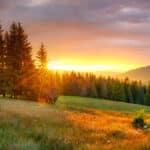I live in an old place.
Our farm sits on karst limestone, a sedimentary rock composed largely of the shells and skeletons of marine organisms that lived in a shallow sea several hundred million years ago. I find their fossils on ridges 4,000 feet higher than the Atlantic Ocean.
We live on the Allegheny Front in the Valley-and-Ridge section of the Appalachian Mountains. The Front — a 180-mile-long, Southeast-facing escarpment that runs from Pennsylvania through eastern West Virginia — generally functions as the Eastern Continental Divide. Colliding tectonic plates pushed up these mountains higher than the Himalayas in the Silurian Period, 418 to 445 million years ago.
We live on the remnants of these peaks, which are among the world’s oldest and, like old teeth, have been slowly reduced to their nubs.
Blue Grass lies along the South Branch of the Potomac River in what until the mid-1940s had been called, “Crab Bottom.” I would rather hail from Crab Bottom than Blue Grass any day, but my wife, Melissa, our Commonwealth Attorney who’s coming up for reelection, believes this is one pot that does not need to be restirred by the likes of me. So I’ll keep this opinion to myself.
It would be easy — too easy — to say that I like old better than new. But just to get my prejudices out in the open—I prefer old cars, old clothes, old watches, old telephones, old houses, old furniture, old music, old fiction and men and women of a certain age.
I admit that I’m not consistent. I like color television and desktop computers. I like some new tools and some new foods. I go for cotton, wool and leather, but some synthetic materials keep me warmer and drier.
I like email, but phooey on cell phones. According to a long-ago girlfriend, Devra Davis, author of Disconnect: The Truth About Cell Phone Radiation, What the Industry Has Done to Hide It, and How to Protect Your Family (Penguin, 2010), these earrings are linked to brain cancer, damaged DNA, increased memory loss and reduced sperm count. Children are especially vulnerable, she writes. I’ve heard it said that people who yak away while using public restrooms deserve higher risk for these maladies, particularly lower sperm counts.
When you get to a certain age, you start coming down more and more on the old side of things. You’re more comfortable with what’s familiar, with the stuff that was new when you were young and now is old.
People tend to become more cautious and conservative as they get older if only because they’ve seen how hard it is to recover from choices that end badly. One advantage of being old is that you have a sense of how certain situations tend to play out because you’ve been through them before.
This produces wise advice to children who believe that they invented the first wheel and all of its recent reinventions, including the wheel of fortune. Age allows me to make truthful statements like: “You’ll see,” which drives the youth of our Nation deservedly batty.
I’m not defending universal fuddy-duddyism, because that’s a dead end. But I do favor pitching all new things into one of three bins: 1) safe, useful and worth the money; 2) not safe, or not useful or not worth the money; and 3) contrivances that were better left uninvented and should, therefore, be shunned.
My 24-year-old daughter and I disagree over where to toss Starbucks and the ever-anal Martha Stewart.
Living in Blue Grass encourages preferring old over new. Our county of 2,500 is older than average by a lot. Retirees move in, and high school graduates move out, which means we become different as we get older. Our farms — with the exception of the poultry houses — are small, inefficient and labor-intensive. They trace back 250 years. No one expects them to turn a profit, not even the IRS.
One hundred years ago is still pretty close and 200 years is not that far back. Some maples on Snowy Mountain were turning in October when George Washington and his buddies were around these parts working sweetheart land deals with the King’s government. I can walk in my back field and occasionally find a stone arrowhead, which is about all that’s left of the folks who hunted this ground for 10,000 years.
The old life was hard. Babies died. Women “got wore out.” Medicines and doctoring were primitive. “Creature comfort” was more applicable to the barn than the first log cabins. The 12 Foxfire books never showed much about this side of the old ways, since there isn’t much of a modern market for self-denial, sacrifice and hardship.
So we cherry pick the old—we value the nice old and park the bad old behind our memory barns. Our tourist-oriented celebrations of the past are about crafts, maple syrup, apple butter and music.
Moonshine — ethanol that has been processed into alcohol and untaxed — is still around so to speak. But it’s hardly worth the effort and risk. I’m waiting for the few surviving moonshiners to start selling corn-based ethanol to gasoline refineries…or most of it, anyway.
The nice thing about living in a small, old, rural place is that we don’t have many people. That’s also the reason we can’t generate much economic growth with our own resources. On some days, I think we need another 1,000 people if only to keep our school system — which graduates 20 kids a year — viable. On other days, 1,000 fewer would suit me.
And if I had a choice about recruiting 1,000 people, they’d be locals who had been out in the world for a while and outsiders who wanted to be here, all in their prime years, 30-50, ready to bring their education, resources, experience, energy and ideas to mix with what’s already here.
Time is always running out for young and old alike. The older we are, the bigger the clock and the louder its dinger. My big clock encourages me to “use time wisely,” which my elementary report cards always said I failed to do.
Rural areas have often been thought of as places where things change slowly, where old keeps out new. I’m not sure that’s true anymore. What’s new about this old place is how quick we now are to go new. We don’t resist change the way we once did.
Our restaurants now serve wraps (which, in my day, were inedible shawls that spent their days in a “cloak room”); our farmers drive tractors from Japan and India; our houses have satellite dishes; our people use computers and email (with a few holdouts); our county may get a small wind farm; and there’s even talk about a Subway Restaurant making a permanent stop in our county seat, a town of about 250.
Old places used to be where you got stuck in the mud. No more.
Now, we may start thinking about selling genuine Silurian mud online.
Suggestions are welcome as to which of my three bins deserves to be filled with this idea.
This content may not be used or reproduced in any manner whatsoever, in part or in whole, without written permission of LANDTHINK. Use of this content without permission is a violation of federal copyright law. The articles, posts, comments, opinions and information provided by LANDTHINK are for informational and research purposes only and DOES NOT substitute or coincide with the advice of an attorney, accountant, real estate broker or any other licensed real estate professional. LANDTHINK strongly advises visitors and readers to seek their own professional guidance and advice related to buying, investing in or selling real estate.







Add Comment